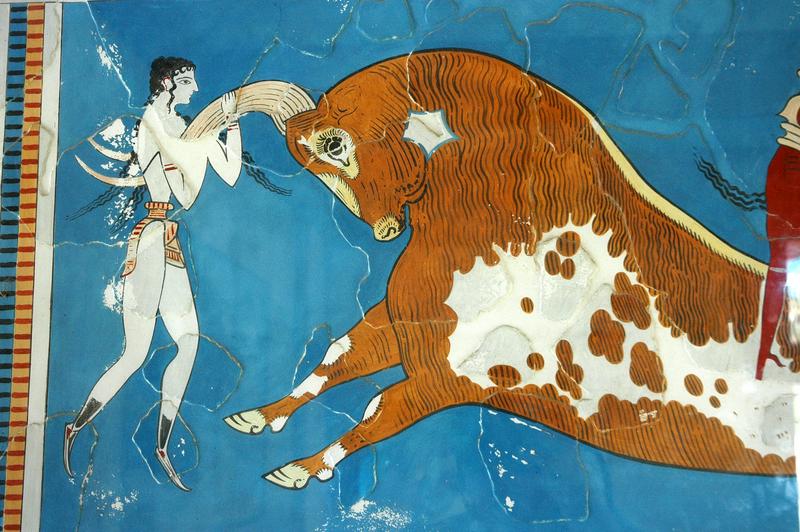That’s No Bull: The Minoans And Their Fascination With Bovines
By | June 13, 2019

The Minoan culture controlled Crete, an island in the Mediterranean Sea south of Greece from about 2000 to 1600 BCE. Theirs was a sophisticated and advanced society. One of the earliest European civilizations, the Minoans had running water and paved roads, for instance, long before other cultures. They created beautiful, intricate mosaics, as well as other, pieces of art. For such a cultured group of people, they had one theme that permeated through their entire society…their worship of the bull. Let’s look at how the bull became a symbol of Crete and how the Minoan bull cult led to some enduring myths and legends.

King Minos and the Birth of the Minoan Civilization
According to the Greek myths, Minos was the son of Zeus. Through a series of unfortunate events, Zeus turned Minos into a bull. Europa, a Phoenician princess, found herself oddly smitten with the beautiful white bull. She climbed onto the creature’s back and rode with him all the way to Crete. There, Minos – apparently transformed back into a man – became the king of the island nation, married Europa, and had several kids with him. Under King Minos’s rule, Crete became a political and economic powerhouse and the Minoan navy even defeated Athens in battle.

The Minotaur
As the son of a god, King Minos frequently hobnobbed with the gods. He offered advice to his father Zeus from time to time. Once time, King Minos asked Poseidon for a white bull that he planned to offer as a sacrifice to the gods. Poseidon obliged and delivered a beautiful bull to Minos. The King decided he would keep the bull for himself instead of sacrificing it as he promised. This angered Poseidon. To punish King Minos, Poseidon made the King’s wife fall in love with the sacrificial bull and consummate their love. When his wife gave birth to a half-man, half-bull monster, King Minos had the fearsome creature locked away.

The Legend of the Labyrinth
To house the half-man, half-bull Minotaur and to keep the cities of Crete safe, King Minos ordered that a vast network of tunnels and passageways be constructed under the island. The Minotaur roamed the maze of the labyrinth, but he got hungry from time to time. Since King Minos had defeated Athens, the ruler demanded a Hunger Games-like tribute from the people of Athens every nine years. He commanded that seven young Athenian boys and seven young Athenian girls be brought to Crete. They were tossed into the labyrinth with the hungry beast. As the youths struggled to find their way through the maze, the hungry Minotaur would pick them off one by one and make them his meal. This brutal practice went on, according to stories, until Theseus, prince of Athens, disguised himself as a tribute and killed the Minotaur.

Worship of the Bull
The bull was an important symbol to the people of Crete. It can be seen on pottery, frescos, and coins of the time. The bull represented the sun and the power of light. For the Minoans, the bull also served as a symbol of power and might, particularly the power of man over nature. This proved to be ironic since the Minoan civilization was destroyed in a volcanic eruption.

Grabbing the Bull by the Horns
The ancient Minoans are credited with giving the world the phrase, “grabbing the bull by the horns.” Certainly, King Minos and his navy showed that they had initiative and could seize opportunities, but the Minoan people also took the idiom literally. According to legends and depictions on frescos, the Minoans engaged in the practice of bull-leaping. Bull-leaping was a test of an individual’s bravery and ability to dominate. With an angry bull changing toward a person, the individual would grasp the horns of the animal and leap over it is a handstand fashion to land safely on the ground behind the bull. It is every bit as dangerous as it sounds.

